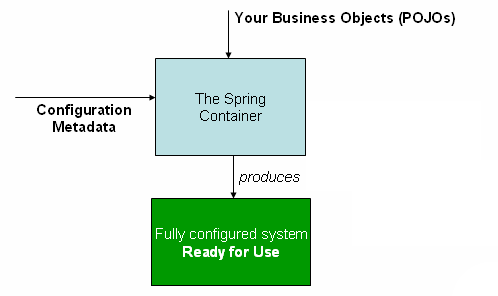[原文](https://docs.spring.io/spring/docs/5.0.6.RELEASE/spring-framework-reference/core.html#spring-core)
接口ApplicationContext表示spring容器,并負責實例化、配置、組裝beans。容器通過讀取配置元數據來獲取那些需要實例化、配置、組裝的對象信息。配置元數據可以使用xml、java注解,java代碼表示。
spring提供了接口ApplicationContext的幾個開箱即用的實現。在單獨的應用中通常會創建一個ClassPathXmlApplicationContext或FileSystemXmlApplicationContext的實例。雖然xml是配置元數據的傳統格式,但你也可以通過少量的xml配置來聲明支持使用java注解或代碼作為配置元數據。
在大多數應用場景中,不需要顯示的代碼來實例化spring容器。例如在web應用中,web.xml文件中簡單的8行左右描述信息就足夠了([參考這里](https://docs.spring.io/spring/docs/5.0.6.RELEASE/spring-framework-reference/core.html#context-create))。
下圖是spring工作的原理圖,類和配置數據組合在一起,當ApplicationContext創建和實例化后,你就擁有一個可執行的應用及其完整的配置

- 正確打開本書的姿勢
- 第一部分 Core
- 1. Ioc container
- 1.1. Introduction to the Spring IoC container and beans
- 1.2. Container overview
- 1.2.1. Configuration metadata
- 1.2.2. Instantiating a container
- 1.2.3. Using the container
- 1.3. Bean overview
- 1.3.1. Naming beans
- 1.3.2. Instantiating beans
- 1.4. Dependencies
- 1.4.1. Dependency Injection
- 1.4.2. Dependencies and configuration in detail
- 1.4.3. Using depends-on
- 1.4.4. Lazy-initialized beans
- 1.4.5. Autowiring collaborators
- 1.4.6. Method injection
- 1.5 Bean Scopes
- 1.6. Customizing the nature of a bean TODO
- 1.7. Bean definition inheritance TODO
- 1.8. Container Extension Points TODO
- 1.9. Annotation-based container configuration
- 1.9.1. @Required
- 1.9.2. @Autowired
- 1.9.3. Fine-tuning annotation-based autowiring with @Primary
- 1.9.4. Fine-tuning annotation-based autowiring with qualifiers TODO
- 1.9.5. Using generics as autowiring qualifiers TODO
- 1.9.6. CustomAutowireConfigurer TODO
- 1.10. Classpath scanning and managed components
- 1.10.1. @Component and further stereotype annotations
- 1.11. Using JSR 330 Standard Annotations TODO
- 1.12. Java-based container configuration
- 1.12.1. Basic concepts: @Bean and @Configuration
- 1.12.2. Instantiating the Spring container using AnnotationConfigApplicationContext
- 2. Resources
- 2.1. Introduction
- 2.2. The Resource interface
- 2.3. Built-in Resource implementations
- 2.3.1. UrlResource
- 2.3.2. ClassPathResource
- 2.3.3. FileSystemResource
- 2.3.4. ServletContextResource
- 2.3.5. InputStreamResource
- 2.3.6. ByteArrayResource
- 2.4. The ResourceLoader
- 2.5. The ResourceLoaderAware interface
- 2.6. Resources as dependencies
- 2.7. Application contexts and Resource paths
- 2.7.1. Constructing application contexts
- 2.7.2. Wildcards in application context constructor resource paths
- 2.7.3. FileSystemResource caveats
- 3. Validation, Data Binding, and Type Conversion
- 4. Spring Expression Language (SpEL)
- 5. Aspect Oriented Programming with Spring
- 5.1. Introduction
- 5.1.1. AOP concepts
- 5.1.2. Spring AOP capabilities and goals
- 5.1.3. AOP Proxies
- 5.2. @AspectJ support
- 5.2.1. Enabling @AspectJ Support
- 5.2.2. Declaring an aspect
- 5.2.3. Declaring a pointcut
- 5.2.4. Declaring advice
- 5.2.5. Introductions TODO
- 5.2.6. Aspect instantiation models TODO
- 5.2.7. Example
- 5.3. Schema-based AOP support TODO
- 5.4. Choosing which AOP declaration style to use TODO
- 5.5. Mixing aspect types TODO
- 5.6. Proxying mechanisms
- 5.6.1. Understanding AOP proxies
- 5.7. Programmatic creation of @AspectJ Proxies
- 5.8. Using AspectJ with Spring applications
- 5.8.1. Using AspectJ to dependency inject domain objects with Spring
- 5.8.2. Other Spring aspects for AspectJ
- 第二部分 Testing
- 第三部分 Data Access
- 1. Transaction Management
- 1.1. Introduction to Spring Framework transaction management
- 1.2 Advantages of the Spring Framework’s transaction support model
- 1.2.1. Global transactions
- 1.2.2. Local transactions
- 1.2.3. Spring Framework’s consistent programming model
- 1.3. Understanding the Spring Framework transaction abstraction
- 1.4. Synchronizing resources with transactions
- 1.4.1. High-level synchronization approach
- 1.4.2. Low-level synchronization approach
- 1.4.3. TransactionAwareDataSourceProxy
- 1.5. Declarative transaction management
- 1.5.1. Understanding the Spring Framework’s declarative transaction implementation
- 1.5.2. Example of declarative transaction implementation
- 1.5.3. Rolling back a declarative transaction
- 1.5.4. Configuring different transactional semantics for different beans
- 1.5.5. tx:advice元素的 settings
- 1.5.6. Using @Transactional
- 1.5.7. Transaction propagation
- 1.5.8. Advising transactional operations
- 1.5.9. Using @Transactional with AspectJ TODO
- 第四部分 web servlet
- 第五部分 Web Reactive
- 第六部分 Integration
- 第七部分 Languages
